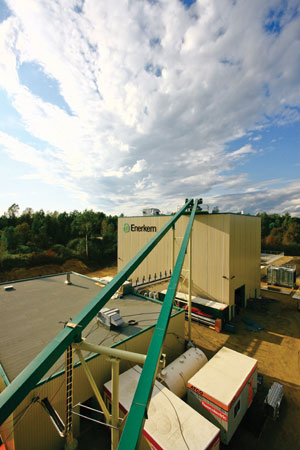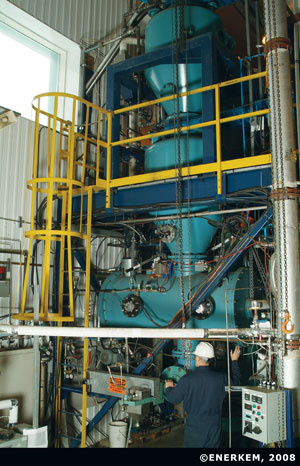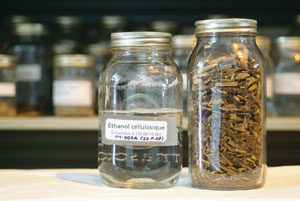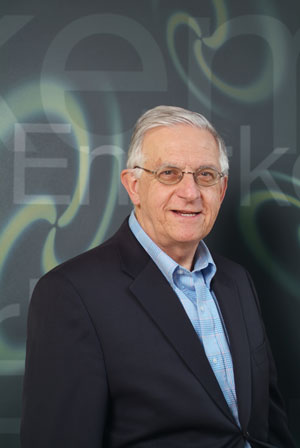
Landfill Ethanol
August 24, 2009
By André Dumont
In the race for successful commercial production of second-generation
ethanol, Enerkem has chosen a radically different approach than most
competitors.
In the race for successful commercial production of second-generation ethanol, Enerkem has chosen a radically different approach than most competitors. Its “carbon recycling technology” is based on a thermochemical process that has nothing to do with finding the best enzymes to break down cellulose and produce ethanol from specific feedstocks such as wheat straw or wood chips. Instead, Enerkem uses gasification to turn carbon-rich feedstocks into synthetic gas, or syngas, which is then converted to ethanol using a catalyst.
 |
|
| The demonstration plant in Westbury, Quebec, uses the outer layer of decommissioned utility poles, which formerly was sent to a landfill.
|
More than 20 types of feedstock have been tested successfully in the Quebec-based company’s research facility and pilot plant. Woodchips, wheat straw, chicken manure, dewatered municipal sludge, and even glycerin can be fed into the gasifier and turned into ethanol. However, Enerkem has chosen to pursue nonhomogenous biomass that has little or no value. “Our scientific vision of biofuel production makes a clear distinction between homogenous and nonhomogenous biomass,” says company cofounder Dr. Esteban Chornet. “Our company will get carbon where it’s cheapest.” For now, the most attractive source of carbon is household waste: municipalities are paying to get rid of it.
Now retired from the University of Sherbrooke, Quebec, where he held the Industrial Research Chair in Second-Generation Biofuels, Chornet has made it his life-long mission to develop an efficient, logical, and sustainable alternative to fossil fuels. The best way of achieving this, he found, was through gasification.
Just like first-generation ethanol technology, the technology of gasification is not new. Coal, for instance, can easily be gasified, and the gas burned to produce energy. But Enerkem goes a few steps further. After gasifying the feedstock in an autothermal fluidized bed gasifier that reaches a temperature of 800°C, the resulting syngas is cleaned and conditioned before entering a catalytic reactor that turns it into alcohol. The beauty of Enerkem’s technology is that it can accept “dirty” biomass like treated wood, municipal sludge, or what’s left of municipal solid waste (MSW) after most recyclables and compostables have been removed.
Feedstock pre-treatment is limited to drying and shredding. In the case of MSW, metal and glass must be removed. The byproducts of the biofuel process are water and inert materials that can be used as aggregates for construction materials such as bricks.

|
|
| Over 20 types of biomass feedstock have been tested in the Sherbrooke pilot plant. |
Advanced biofuels
Enerkem calls its second-generation ethanol an advanced biofuel. Even though most feedstocks that the company has tested contain cellulose, Enerkem tends to avoid the cellulosic ethanol label, leaving it for companies that focus on efficient ways of breaking down cellulose using biochemical processes.
Second-generation biofuels are all about using feedstocks that have less value than corn or sugar cane. What differentiates Enerkem from other second-generation biofuel developers is its main interest in what it calls negative-value biomass, which usually requires a tipping fee for disposal. “We get paid to receive our feedstock,” says Marie-Hélène Labrie, government affairs and communications vice-president. “What we do is unique. We are the only industry player going for garbage.”
Enerkem’s intriguing technology draws dozens of visitors to its pilot plant in downtown Sherbrooke. The plant was started in 2003, three years after Esteban Chornet founded the company with his son Vincent, who was previously involved in assisting start-up companies in the chemical, energy, and biotech sectors.
The Sherbrooke plant has now completed over 3600 hours of operation. Its capacity of 475,000 litres/year makes it ideal for testing, but too small for continuous operation. “This is our playground,” says Daniel Arguin, vice-president of engineering and implementation.
After working for 25 years in key positions with Canadian, U.S., and European industrial giants, Arguin is back to his alma mater, where Chornet once taught him chemical engineering. He is so confident about Enerkem’s technology that his tour of the pilot plant includes a candid admission that most of the equipment was bought on eBay. “Delivery times are very short,” he says with a smile.
The gasification and catalytic conversion technologies use standard industrial equipment. Tweaking it is what takes time and effort. The results are analyzed in University of Sherbrooke laboratories.
“We run a lot of trials,” says Arguin. “Results are not always good, but we learn a lot.”
 |
|
| To produce ethanol, Enerkem gasifies any type of biomass and reacts the syngas with a catalyst.
|
Development and expansion
The company’s credibility and ability to draw investors stems from its rigorous scientific approach, says Arguin. Few bioenergy start-ups can boast to have been running a pilot plant for more than six years with such a high number of hours of operation.
In 2007, Enerkem began construction of an industrial demonstration plant in Westbury, located 25 km east of Sherbrooke. This facility stands next to a sawmill that recycles used utility poles and provides the shredded outer layer to Enerkem; prior to this, the outer layer was sent to a landfill. “The inner core is recycled into four-by-fours or six-by-sixes,” says Arguin. “We take the outer part and turn it into ethanol.”
The Westbury facility is expected to produce five million litres/year of second-generation ethanol when operational. More importantly, it will demonstrate the technological and commercial good sense of using negative-cost materials that are usually landfilled. The plant is currently producing syngas and should become fully operational in the fall of 2009, when it installs catalytic reactors to produce ethanol from the syngas.
Enerkem’s first full-scale plant will be built in Edmonton, Alberta, with construction beginning in the fall of 2009. The plant will be 10 times bigger than the one at Westbury and will be “the world’s first commercial municipal waste-to-biofuel facility,” the company says. A 25-year agreement has been signed with the City of Edmonton, which will supply 100,000 tonnes/year of sorted MSW.
The plant, which is expected to start production in 2010, is being implemented in partnership with Ontario-based Greenfield Ethanol, a corn-ethanol producer. Upon completion, the $70-million plant will produce 36 million litres/year of ethanol. This will reduce Edmonton’s carbon dioxide footprint by six million tons over 25 years, the equivalent of taking 12,000 cars off the road each year.
“Edmonton will really be the gate-opener for us,” says Arguin. “That plant will become a worldwide reference.”
With the Edmonton project, Enerkem will be showcasing the first of an unlimited number of 36-million-litre ethanol plants it hopes to build. By standardizing the size and outfitting of its facilities, Enerkem hopes to reduce costs and risks associated with each new project.
Arguin admits that Enerkem’s typical ethanol production module will be relatively small. By processing only 400 tonnes/day of refuse, this limits the number of garbage trucks entering the site to about 30. However, Arguin notes that this size makes the financing and public acceptance of new plants easier. This scale of approach will also allow Enerkem to use existing standard industrial equipment. All tailor-made parts will be manufactured in the Sherbrooke area in machine shops that are looking for new business now that the pulp and paper industry is on the decline. Everything will be small enough to be freighted in one piece to a plant’s construction site, says Arguin.
After Edmonton, Enerkem’s next major project will be located in the state of Mississippi. In March, the company signed a memorandum of understanding with a five-county regional waste management authority for the supply of 189,000 tons of unsorted MSW. Under the current scenario, Enerkem will assemble two of its standard waste-to-ethanol modules at a landfill site. It also plans to build recycling units for paper, metal, and glass; whatever cannot be recycled will be turned into ethanol. The plant will also accept forestry biomass from area companies.
Each production unit can be fed different types of feedstock. The major difference in handling various feedstocks is in the pre-treatment, to ensure that the feedstock that enters the gasifier is in small enough pieces and at less than 25% moisture content. This flexibility is what could bring Enerkem to municipalities throughout Canada. In regions that have too little MSW available to operate a plant at capacity, the plant could also use locally available forestry or agricultural biomass. “The key is to secure a stable supply of feedstock,” says Labrie. Before investing, Enerkem requires a long-term agreement that indicates how much feedstock it will receive and how much money it will get for taking it.

|
|
| Dr. Esteban Chornet is Enerkem’s co-founder and chief technology officer.
|
For the future
Enerkem is ready to go big. “We want to have multiple facilities built every year,” says Arguin, without further revealing company objectives. He says that the current workforce of 56 employees is up to the challenge of managing exponential growth.
Financing so far has come in the form of private funds from company management, government subsidies, and venture capital (Rho Ventures and Braemar Energy Ventures of the United States, and Canada’s BDR Capital). Partnerships are sought for new projects, but Enerkem wants to own and operate all new facilities. “We are not selling our technology,” says Arguin.
Enerkem is already a world leader in second-generation biofuel generation, says Labrie. No one has been eyeing MSW as a feedstock for ethanol production for as long as Esteban Chornet has. Now, Enerkem is going commercial and it’s getting paid both for taking the feedstock and for making ethanol out of it, says Labrie. “The world is watching us!” •
| Biomass Gasoline Some companies are avoiding ethanol altogether in a quest to produce drop-in synthetic hydrocarbon transportation fuels (like gasoline) from biomass. In this process, finely ground biomass is rapidly decomposed under high temperatures to yield pyrolysis oil and other products. The pyrolysis oil is then upgraded and refined to make synthetic gasoline, diesel, and jet fuel. This upgrading and refining technology is currently being developed and improved by various industry players. Envergent Technologies, headquartered in Des Plaines, Illinois, is a new joint venture of Ensyn and UOP. The company has demonstrated that pyrolysis oil produced using Ensyn’s pyrolysis technology can be further upgraded to transportation fuels using UOP’s hydroprocessing technology. It claims that the process produces gasoline, diesel, and jet fuels that are virtually indistinguishable from their petroleum-based counterparts. The process has been demonstrated in the laboratory, and the company is developing commercial-scale technology that it anticipates could be available for Dynamotive Energy Systems, headquartered in Vancouver, British Columbia, also uses a hydro-reforming process to upgrade its pyrolysis oil to liquid hydrocarbon fuels. In a recent press release, it states that independent and internal analyses of its stage 2 upgraded pyrolysis oil indicate that the mixture contains components similar to a crude oil fraction, with distillation fractions of approximately 20% gasoline, 30% jet, 30% diesel, and 20% vacuum gasoil by weight. Construction of a pilot plant may begin in late 2009, pending financing.
– Heather Hager
|
Print this page